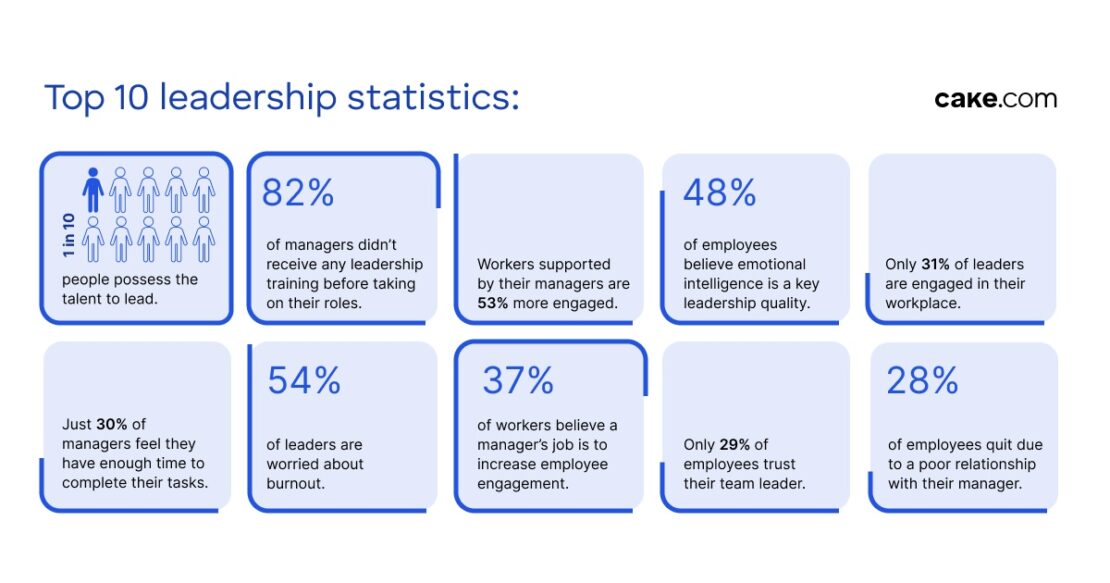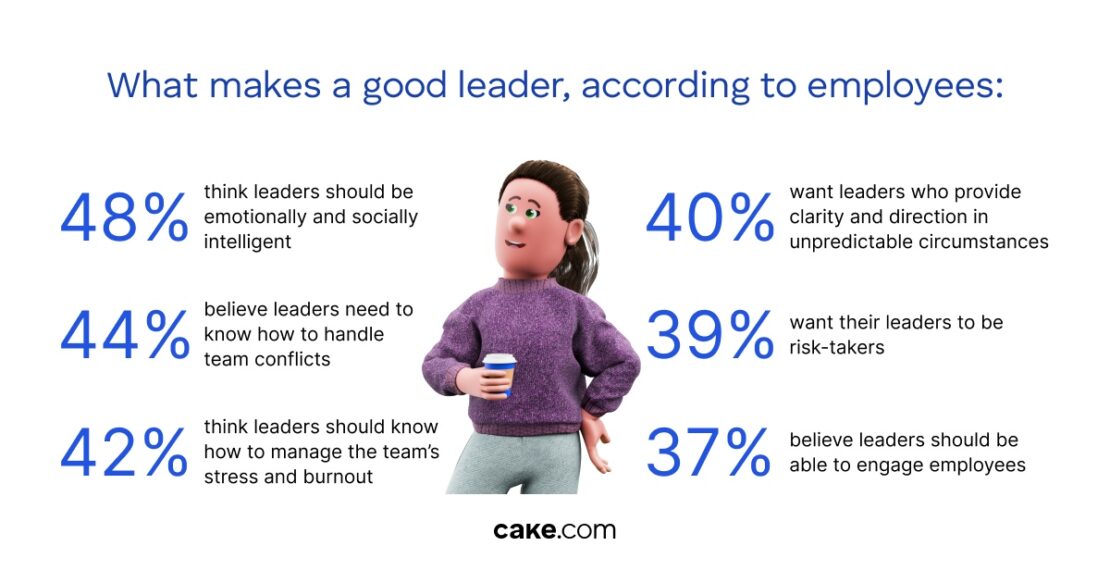What qualities make a good leader? How many employees believe their supervisor is successfully leading and motivating them? Are leaders satisfied with their jobs?
These are just some of the leadership insights we’re covering in this article.
So, keep reading if you want to learn all about the state of leadership today!
- 1 in 10 people possess the talent to lead.
- 82% of managers didn’t receive any leadership training before taking on their roles.
- Workers supported by their managers are 53% more engaged.
- 48% of employees believe emotional intelligence is a key leadership quality.
- Only 31% of leaders are engaged in their workplace.
- Just 30% of managers feel they have enough time to complete their tasks.
- 54% of leaders are worried about burnout.
- 37% of workers believe a manager’s job is to increase employee engagement.
- Only 29% of employees trust their team leader.
- 28% of employees quit due to a poor relationship with their manager.

Crucial statistics on leadership hiring and training
Is leadership a talent or a skill? How many qualified people take on a leadership role?
These stats paint a better picture of how difficult it is to find the right person for a management position and how often managers fulfill their roles without training.
Companies don’t choose the right person for the management job in 82% of cases
According to research by Gallup, an alarming percentage (82%) of organizations don’t succeed at picking a suitable candidate with the right talent for a managerial position.
Gallup also reports reasons why managers were picked for their leadership roles. The most common answers? Being successful at their non-managerial positions and being a part of the company for a long time.
So, not picking managers based on their leadership skills might be why companies frequently fail to choose the right candidate.
1 in 10 people have the talent to manage
Another interesting stat from the same Gallup research is that just 1 in 10 US adults actually possess a talent to manage.
A more positive, but still not too comforting number is that 2 in 10 people have some basic managerial characteristics. This means they have the potential to become good managers with proper coaching.
82% of managers didn’t receive training before taking on their roles
A recent CMI report on UK managers shows that 82% of supervisors were “accidental managers”. This means they didn’t have any kind of leadership training or preparation for their managerial roles.
In fact, 33% of current managers still haven’t received any management and leadership training. The number is slightly lower but still high for senior management — 26% of them never received formal management training.
What qualities make a good leader?
What are the qualities of a good leader? Let’s see what employees think.
48% of employees believe their leaders need to be emotionally intelligent
A 2024 Harvard Business Publishing study explored the key competencies workers think leaders should have. Nearly half (48%) of them believe a leader has to be socially and emotionally intelligent.
This is the second most important leadership quality. The first one, picked by 50% of workers, is the ability to connect the team with the organization’s purpose.
Further reading:
Being a manager doesn’t necessarily mean you’re also a leader. Find the key differences between leadership and management in this blog post:
44% of workers think their leader should be able to manage team conflicts
Another essential leadership quality explored in the Harvard Business Publishing study is the ability to handle conflicts within the team. As many as 44% of workers think conflict management should fall on their leader; therefore, leaders need to be able to mitigate any issues that arise within the team.
A good manager should also provide clarity and direction in dynamic, unpredictable circumstances. This is important for 40% of employees.
37% of employees believe a manager’s job is to engage employees
Many workers (37%) believe their leader should know how to increase and maintain their engagement.
Here are other crucial management qualities mentioned in the Harvard Business Publishing study:
- 42% of workers think the manager needs to be able to manage the team’s stress and burnout,
- 39% of employees believe managers should be risk-takers, and
- 36% of study participants think a manager has to be tech-savvy and adaptable.

How do leaders feel at their workplace?
Are leaders happy at their jobs? Do they feel more stressed than before?
Let’s find out.
Only 31% of leaders are engaged in their workplace
Leaders’ engagement levels are at an all-time low, the 2024 Gallup Leadership Research reports.
In November 2024, only 31% of managers were engaged. In comparison, the percentage of engaged leaders sat at 34% in November 2023. The numbers were even higher for previous years: 36% in 2021 and 38% in 2020.
Just 18% of managers are satisfied with their jobs
The same Gallup research also reports extremely low job satisfaction levels for managers. While this number remained the same since 2023, leadership contentment was much higher in previous years.
For instance, in 2020, 26% of leaders were satisfied with their job.
75.29% of women in leadership positions are satisfied with their work-life balance
According to the CAKE.com Women in Tech Report, the majority (75.29%) of female tech leaders are satisfied with how they’re juggling their personal and professional commitments.
Out of them, 25.29% are very satisfied, while 50% are somewhat satisfied with their work-life balance.
71% of leaders report higher stress levels
For 71% of people, taking on a leadership role contributed to their stress levels, 2025 DDI research shows.
To put things in perspective, in 2022, 63% of managers reported higher stress levels than before. Thus, it seems that leaders nowadays face more pressure when taking on this responsibility than a few years ago.
30% of leaders feel they have enough time to complete their tasks
The same DDI research also showed that only a small percentage of managers (30%) have enough time to properly carry out their responsibilities. The main reasons for this issue include inadequate time allocation and the lack of information and tools.
Further reading:
Did you know that 47% of employees spend up to 5 hours of their day looking for specific information? Explore other interesting knowledge management stats in this blog post:
The DDI study found a direct correlation between the lack of resources and time with burnout, showcasing the importance of mitigating managerial challenges before it’s too late.
54% of leaders are worried about burnout
More than half of the people in leadership positions are emotionally exhausted and are close to burning out, the same DDI study reports.
So, it comes as no surprise that 40% of them have considered quitting in the past year as the direct result of the increased stress levels they’re experiencing.
56% of managers are actively looking for a new job
The Gallup Leadership Research we mentioned also found that more than half (56%) of managers are currently searching for a new job. The number of people wanting a change has never been higher.
In comparison, in 2019, 44% of leaders were seeking a new job. The number sat at 46% in 2020.
Stats on the quality of employee-leader relationships
A crucial leadership aspect is the quality of their relationship with the people they’re leading.
These stats showcase the state of the employee-leader relationship and whether employees feel they’re being properly managed.
Workers supported by their managers are 53% more engaged
According to a 2025 Inpulse study, leaders who support their teams have 3.4 times more engaged workers.
Trusting your employees has the same result. Based on the same study, workers whose managers trust them are 53% more likely to be engaged at their workplace.
Further reading:
Struggling with employee engagement? These tips may help:

33% of workers believe trust is essential to a positive relationship
In their 2025 Global Leadership Report, Gallup explored the key aspects of a positive relationship between a follower and a leader, both political and organizational. The study highlighted the value of building trust and fostering a positive leader-follower relationship, with 33% of employees deeming it important.
Compassion is significant for 7% of study participants, while stability is important for 4%.
Further reading:
Good leadership communication is crucial for a positive employee-manager relationship. Learn more about it here:
Only 29% of employees trust their immediate supervisor
The DDI study we previously mentioned explored how employees view their leadership. It found that only 29% of them trust their immediate manager. This is a 17% decrease from 2022!
The study also highlighted that younger employees trust their managers more. For example, 36% of workers aged between 25 and 34 have faith in their supervisors. On the other hand, only 26% of those in the 50–64 age group trust their leader.
Further reading:
Generational differences are also present in other workplace aspects. Here’s how Gen Z, in particular, changed the way we work:
Just 20% of workers feel they’re managed properly
The above-mentioned Gallup Leadership Research established that only 20% of employees feel their performance is managed in a way that enables them to perform great work. This is a 2% decrease from 2023.
The confidence in managers was the highest in 2020 when 24% of employees believed their management was setting them up for success.
Further reading:
One of the ways managers can ensure employees are motivated to perform better is by providing them feedback. Here are ways to make feedback more effective:
29% of employees feel supported by their managers
Less than a third (29%) of workers believe their leaders are supportive of them, the same Gallup research reports.
Moreover, 31% of employees believe their supervisor has created an open and trusting work environment. And, just 27% think their manager is keeping them informed on what’s happening in the organization.
7 in 10 employees would quit due to a bad manager
A recent LinkedIn Market Research showcased the importance of good management. It found that 7 in 10 US employees would resign if they had a bad leader.
The percentages are even larger for younger generations. Namely, 75% of Gen Zers and 77% of Millennials would leave a job because of poor management. The same is true for 68% of Gen X and 61% of Baby Boomers.
28% of employees resigned because of a poor relationship with their manager
The abovementioned CMI report showed that 28% of UK workers already left their previous jobs due to a bad relationship with their supervisor. The report also states that 50% of employees who don’t have a good relationship with their manager plan to quit within the next year.
The rate of leaving due to poor leadership is just as high for managers. Namely, as many as 31% of people in managerial positions resigned because of a bad relationship with the leadership.
A good leader equals an engaged, happy workforce
If these stats have taught us anything it’s that having good leadership is essential for job satisfaction and employee engagement.
But, a good leader is hard to come by — most workers don’t believe their manager possesses the right skills to lead and motivate them. And, the fact that the majority of people don’t go through any kind of training before taking on a management role isn’t helping.
So, we can expect more positive leadership numbers when companies start preparing their employees for leadership roles. In the words of D. Wayne Calloway, business executive and former chairman and CEO of PepsiCo, from a CNN interview:
“I’ll bet most of the companies that are in life-or-death battles got into that kind of trouble because they didn’t pay enough attention to developing their leaders.” – Dr. Wayne Calloway
How we reviewed this post: Our writers & editors monitor the posts and update them when new information becomes available, to keep them fresh and relevant.



